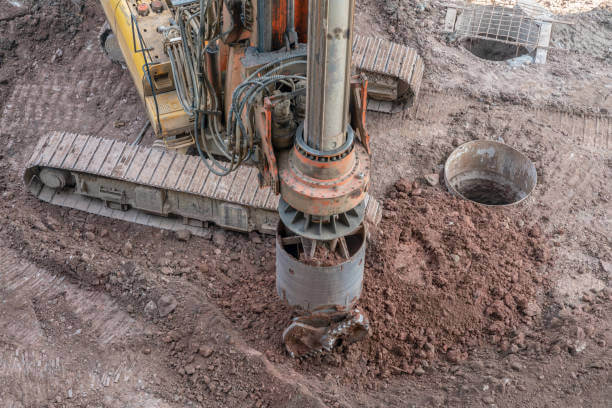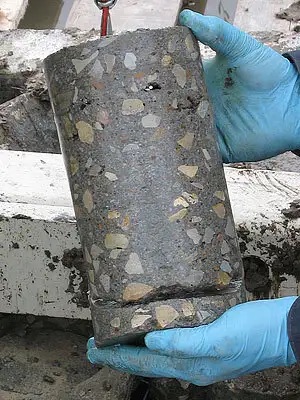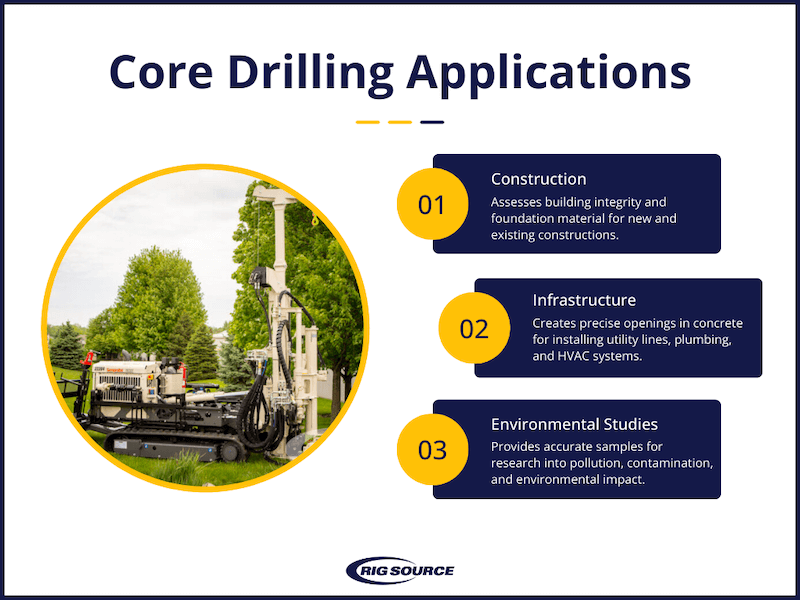Core Drilling: Elevating Construction and Exploration Projects
Core drilling plays an important role across various industries, especially in construction, mineral exploration, and environmental studies. It’s about more than just drilling materials from the ground; it’s about gaining insights for assessing a construction site, checking the safety of existing structures, or searching for valuable minerals.
The Core Drilling Process
Core drilling is a specialized method for extracting a cylinder-shaped sample from the rock or sediment materials under the ground. Unlike traditional drilling, concrete coring allows drillers to retrieve intact samples. This method uses a core drill, which is a hollow, diamond-tipped drill bit that precisely cuts through the underground material. This preserves the core’s structure and composition inside the drill rod.
Once the core samples are extracted, the pieces provide a direct snapshot of the subsurface layer, providing insights into the material’s composition, structural integrity, density, and porosity. The ability to obtain undisturbed, complete samples makes core drilling essential for various applications, from construction and geological exploration to environmental studies. It’s a process that requires precision, allowing professionals to examine the condition of the project site and make sure every decision is based on solid, observed data.
Core Drilling in Action
There are two main types of core drilling: soft coring and hard coring. Soft coring is used for collecting unconsolidated materials like sand or clay. Drillers can reach up to 500 feet with this method by using nested barrels to capture the core samples. The drill bit is typically tipped with carbide or coated with nickel-bonded diamonds for enhanced durability.
On the other hand, hard coring is used for extracting tougher materials at depths up to 5,000 feet. This technique relies on using the barrels to collect intact rock samples from the ground.
Why Core Samples Matter
In construction, the collected core samples are used to evaluate the project’s viability, confirming that the foundation and structural components are built on solid and stable ground. For mineral exploration, core samples can reveal valuable resources hidden underground. Environmental studies rely on these samples to understand soil composition, contamination levels, and other environmental factors that could impact the project.

Core Drilling Equipment and Machinery
Having the right tools for your construction project ensures efficiency and accuracy and defines the success of the drilling operation.
- Diamond Core Drill Bits: Known for their hardness and durability, these bits cut through the toughest materials, including reinforced concrete surfaces and various types of rock. The diamonds embedded in the bit allow for a cutting action that is precise and minimally invasive to the surrounding area.
- Core Barrels: Attached to the drill bit is the core barrel, a tube-like structure that collects rock or soil samples while preserving its natural state for accurate analysis.
- Drill Motors: These provide the power behind the core bit and barrel. They vary in terms of power output, speed, and functionality, with options available for electric, pneumatic, and hydraulic systems. The choice of drill motor depends on the needs of the project, whether it’s the material being drilled, the required depth, and the location of the drilling site.
- Drill String: This is a group of drill pipes that use a rotational motion to provide the necessary torque and drilling fluid to the drill bit.
- Drill Rods: These connect the core barrel to the drill rig, transmitting rotational power and allowing for the depth of the drill bit to be extended as drilling progresses. They are crucial for maintaining stability during the operation.
- Casing Tubes/Pipes: These tubes are placed in the drill hole to strengthen what was just drilled, also removing the hazard of the hole collapsing and caving in.
- Mud Pump: This pump circulates the drilling fluid under high pressure through the drill string, down to the drill bit, and back up to the surface. It removes cuttings and stabilizes the borehole, ensuring a quality core sample.

Different Core Drilling Techniques
There is always a need for greater precision, efficiency, and safety in the construction industry. This opens up various opportunities for different drilling methods. Diamond core drilling is one specific type of core drilling used in the exploration and extraction of minerals. It uses a rotary drill with diamond drill bits to create precise holes in the ground’s surface. While traditional coring cuts through softer materials, diamond drilling involves cutting through the hardest materials, such as metal, glass, and concrete.
The two primary types of diamond drilling are rotary drilling and wireline drilling. These methods differ in how they break up the material drilled from the ground.
- Rotary Drilling: This is primarily used for borehole drilling and is better suited for smaller job sites. It involves cutting through the entire contents of the hole, making it efficient for comprehensive subsurface exploration. It also offers the advantage of producing less waste while providing more samples.
- Wireline Drilling: These systems enable the quick retrieval of solid core samples without needing to remove the entire drill string. The inner barrel removes rock samples from the bottom of the hole, with minimal torque and a more focused extraction of subsurface materials.

Applications of Concrete Core Drilling Rigs
Ensuring Structural Integrity in the Construction Industry
For construction, core drilling is used for assessing the integrity of buildings and infrastructure. Before construction begins, this drilling method can provide data on the foundation material. It’s also used in the renovation and inspection of existing structures, allowing engineers to evaluate the condition of concrete and other materials without causing significant damage.
With infrastructure, core drilling facilitates the installation of utility lines, plumbing, and HVAC systems by creating precise openings in existing concrete structures. This precision ensures that changes can be made with minimal disruption and without compromising the building’s structural integrity.
Sampling for Environmental Studies
Core drill rigs are also used to collect samples for science, providing insights into environmental conditions, pollution levels, and groundwater contamination. For projects assessing the environmental impact of potential developments, this method gives researchers accurate, undisturbed samples for their data.
These are just some of the applications of core drilling. As technology continues to advance, the potential applications expand, offering new opportunities for exploration, construction, and environmental studies.

Rig Source: Enhancing Core Drilling Operations
At Rig Source, our expertise lies in our comprehensive equipment inventory that caters to various drilling needs. We offer a wide range of high-quality drill rigs for environmental, coring and exploration, direct push drilling, and more, ensuring clients have access to the best possible equipment for their specific projects.
We differentiate ourselves by offering an inventory that includes new, rental, and used drill rigs, providing flexible solutions to meet different budgets and project requirements. We carry these rigs from manufacturers such as Atlas Copco, Boart Longyear, VersaDrill Canada, Geoprobe, and more. Through our core drilling equipment inventory, we are committed to serving clients beyond the sale, offering repair and refurbishment services to ensure positive project outcomes. If you’re interested in purchasing a core drill rig or renting a unit, reach out to Rig Source today and we’ll guide you in finding the best equipment for the job.
Resources:
- Boart Longyear. https://www.boartlongyear.com/drillingservice/surface-coring/
- Rig Source. https://rigsourceinc.com/





